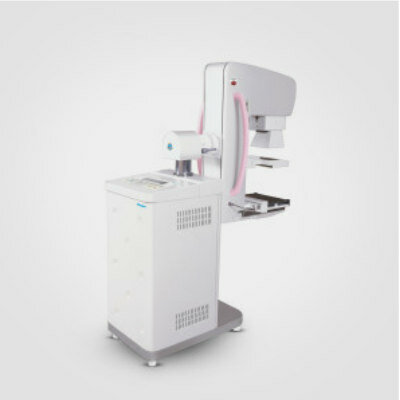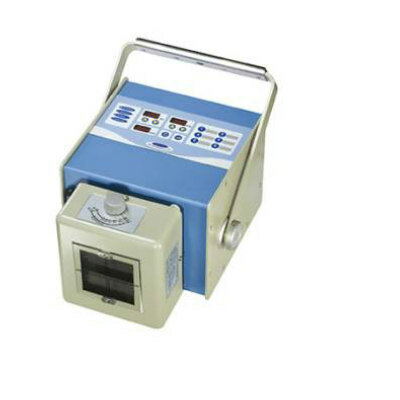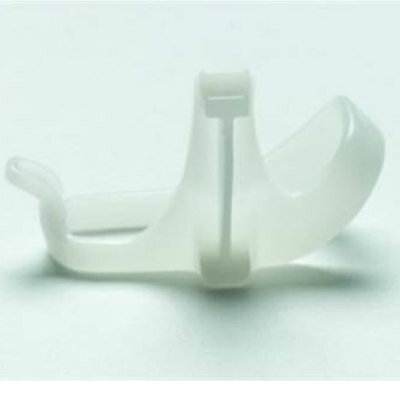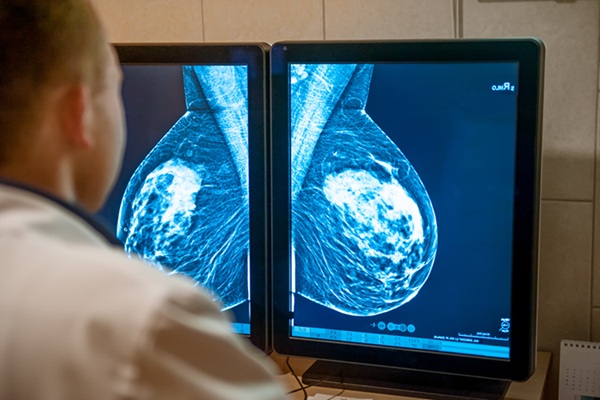AI Tool Accurately Assesses Ischemic Stroke Damage
|
By MedImaging International staff writers Posted on 04 Feb 2019 |
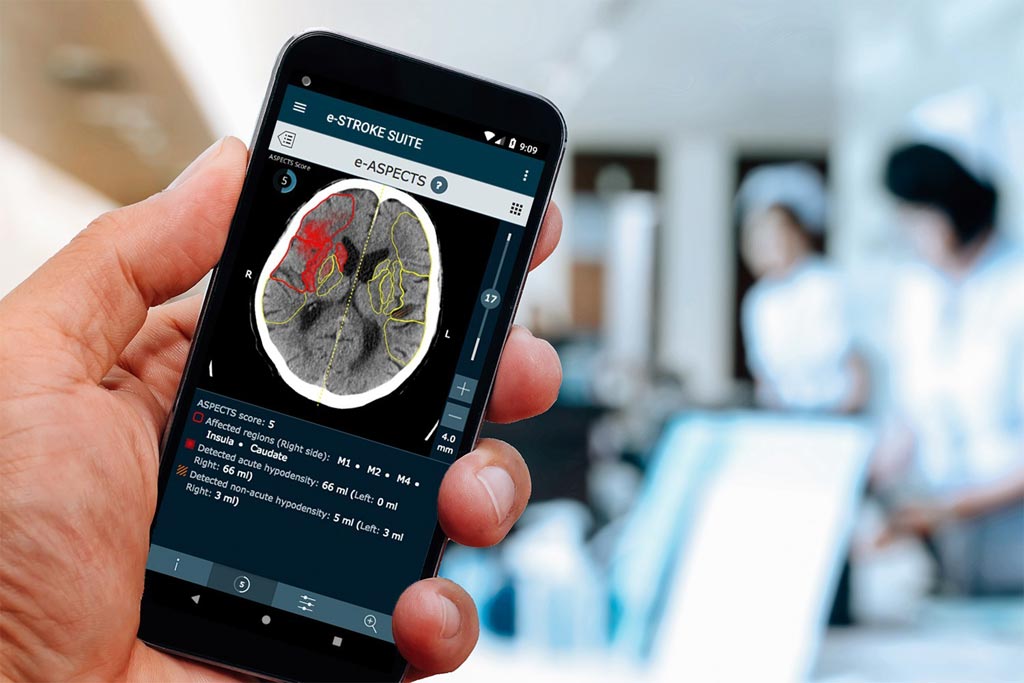
Image: The e-ASPECTS output as viewed on a mobile device (Photo courtesy of Brainomix).
An artificial intelligence (AI) imaging tool supports fast and consistent interpretation of non-contrast computerized tomography (CT) scan.
The Brainomix (Oxford, United Kingdom) e-ASPECTS tool is intended to assist clinicians in brain CT scan interpretation following an ischemic stroke by quantifying the volume of ischemia and grading it with the Alberta Stroke Program Early CT Score (ASPECTS) 10-point quantitative score. By reducing inter-reader variability in interpretation, e-ASPECTS enables a more standardized stroke diagnosis and facilitates fast, consistent treatment decisions, irrespective of physician experience or expertise.
Physicians can review e-ASPECTS results anywhere via picture archiving and communication systems (PACS), through the e-ASPECTS web browser user interface, or by viewing images sent to a clinician's smartphone via email. The wide availability ensures rapid sharing throughout the stroke team and allows faster, more informed decision-making. For users carrying out clinical research, the unique ischemia volume measurement feature in e-ASPECTS provides a fully automated estimate of the ischemic core size on non-contrast CT, even for hyper-acute cases.
A new study, published on October 27, 2018, in the Journal of NeuroInterventional Surgery, suggests that it may be reasonable to select patients for reperfusion therapy in hospitals without access to advanced imaging using the e-ASPECTS tool in combination with clinical criteria, and that e-ASPECTS is a reliable and valuable tool that can save valuable time by providing objective identification of ischemic injury, thus empowering clinicians in selecting patients suitable for mechanical thrombectomy, thrombolysis, endovascular treatment, or for decompressive craniotomy.
“This important study highlights the potential of the Brainomix e-ASPECTS support tool to simplify the selection of stroke patients for thrombectomy presenting in the late time window,” said George Harston, MD, chief medical and innovation officer of Brainomix and a consultant physician at Oxford University Hospitals. “The findings suggest that access to thrombectomy may be broadened to a wider population of patients, and without need for time consuming advanced imaging, which is often not readily available even in larger centers.”
Timely restoration of cerebral blood flow using reperfusion therapy is the most effective maneuver for salvaging ischemic brain tissue that is not already infarcted. For eligible patients with acute ischemic stroke, intravenous alteplase is first-line therapy, provided that treatment is initiated within 4.5 hours of onset. Mechanical thrombectomy is indicated for patients with acute ischemic stroke due to a large artery occlusion in the anterior circulation who can be treated within 24 hours of the time last known to be well, regardless of whether they receive intravenous alteplase for the same ischemic stroke event.
Related Links:
Brainomix
The Brainomix (Oxford, United Kingdom) e-ASPECTS tool is intended to assist clinicians in brain CT scan interpretation following an ischemic stroke by quantifying the volume of ischemia and grading it with the Alberta Stroke Program Early CT Score (ASPECTS) 10-point quantitative score. By reducing inter-reader variability in interpretation, e-ASPECTS enables a more standardized stroke diagnosis and facilitates fast, consistent treatment decisions, irrespective of physician experience or expertise.
Physicians can review e-ASPECTS results anywhere via picture archiving and communication systems (PACS), through the e-ASPECTS web browser user interface, or by viewing images sent to a clinician's smartphone via email. The wide availability ensures rapid sharing throughout the stroke team and allows faster, more informed decision-making. For users carrying out clinical research, the unique ischemia volume measurement feature in e-ASPECTS provides a fully automated estimate of the ischemic core size on non-contrast CT, even for hyper-acute cases.
A new study, published on October 27, 2018, in the Journal of NeuroInterventional Surgery, suggests that it may be reasonable to select patients for reperfusion therapy in hospitals without access to advanced imaging using the e-ASPECTS tool in combination with clinical criteria, and that e-ASPECTS is a reliable and valuable tool that can save valuable time by providing objective identification of ischemic injury, thus empowering clinicians in selecting patients suitable for mechanical thrombectomy, thrombolysis, endovascular treatment, or for decompressive craniotomy.
“This important study highlights the potential of the Brainomix e-ASPECTS support tool to simplify the selection of stroke patients for thrombectomy presenting in the late time window,” said George Harston, MD, chief medical and innovation officer of Brainomix and a consultant physician at Oxford University Hospitals. “The findings suggest that access to thrombectomy may be broadened to a wider population of patients, and without need for time consuming advanced imaging, which is often not readily available even in larger centers.”
Timely restoration of cerebral blood flow using reperfusion therapy is the most effective maneuver for salvaging ischemic brain tissue that is not already infarcted. For eligible patients with acute ischemic stroke, intravenous alteplase is first-line therapy, provided that treatment is initiated within 4.5 hours of onset. Mechanical thrombectomy is indicated for patients with acute ischemic stroke due to a large artery occlusion in the anterior circulation who can be treated within 24 hours of the time last known to be well, regardless of whether they receive intravenous alteplase for the same ischemic stroke event.
Related Links:
Brainomix
Latest Imaging IT News
- New Google Cloud Medical Imaging Suite Makes Imaging Healthcare Data More Accessible
- Global AI in Medical Diagnostics Market to Be Driven by Demand for Image Recognition in Radiology
- AI-Based Mammography Triage Software Helps Dramatically Improve Interpretation Process
- Artificial Intelligence (AI) Program Accurately Predicts Lung Cancer Risk from CT Images
- Image Management Platform Streamlines Treatment Plans
- AI-Based Technology for Ultrasound Image Analysis Receives FDA Approval
- AI Technology for Detecting Breast Cancer Receives CE Mark Approval
- Digital Pathology Software Improves Workflow Efficiency
- Patient-Centric Portal Facilitates Direct Imaging Access
- New Workstation Supports Customer-Driven Imaging Workflow
Channels
Radiography
view channel
AI Generates Future Knee X-Rays to Predict Osteoarthritis Progression Risk
Osteoarthritis, a degenerative joint disease affecting over 500 million people worldwide, is the leading cause of disability among older adults. Current diagnostic tools allow doctors to assess damage... Read more
AI Algorithm Uses Mammograms to Accurately Predict Cardiovascular Risk in Women
Cardiovascular disease remains the leading cause of death in women worldwide, responsible for about nine million deaths annually. Despite this burden, symptoms and risk factors are often under-recognized... Read moreMRI
view channel
AI-Assisted Model Enhances MRI Heart Scans
A cardiac MRI can reveal critical information about the heart’s function and any abnormalities, but traditional scans take 30 to 90 minutes and often suffer from poor image quality due to patient movement.... Read more
AI Model Outperforms Doctors at Identifying Patients Most At-Risk of Cardiac Arrest
Hypertrophic cardiomyopathy is one of the most common inherited heart conditions and a leading cause of sudden cardiac death in young individuals and athletes. While many patients live normal lives, some... Read moreUltrasound
view channel
Ultrasound Probe Images Entire Organ in 4D
Disorders of blood microcirculation can have devastating effects, contributing to heart failure, kidney failure, and chronic diseases. However, existing imaging technologies cannot visualize the full network... Read more
Disposable Ultrasound Patch Performs Better Than Existing Devices
Wearable ultrasound devices are widely used in diagnostics, rehabilitation monitoring, and telemedicine, yet most existing models rely on lead-based piezoelectric ceramics that pose health and environmental risks.... Read moreNuclear Medicine
view channel
New Imaging Solution Improves Survival for Patients with Recurring Prostate Cancer
Detecting recurrent prostate cancer remains one of the most difficult challenges in oncology, as standard imaging methods such as bone scans and CT scans often fail to accurately locate small or early-stage tumors.... Read more
PET Tracer Enables Same-Day Imaging of Triple-Negative Breast and Urothelial Cancers
Triple-negative breast cancer (TNBC) and urothelial bladder carcinoma (UBC) are aggressive cancers often diagnosed at advanced stages, leaving limited time for effective treatment decisions.... Read more
New Camera Sees Inside Human Body for Enhanced Scanning and Diagnosis
Nuclear medicine scans like single-photon emission computed tomography (SPECT) allow doctors to observe heart function, track blood flow, and detect hidden diseases. However, current detectors are either... Read more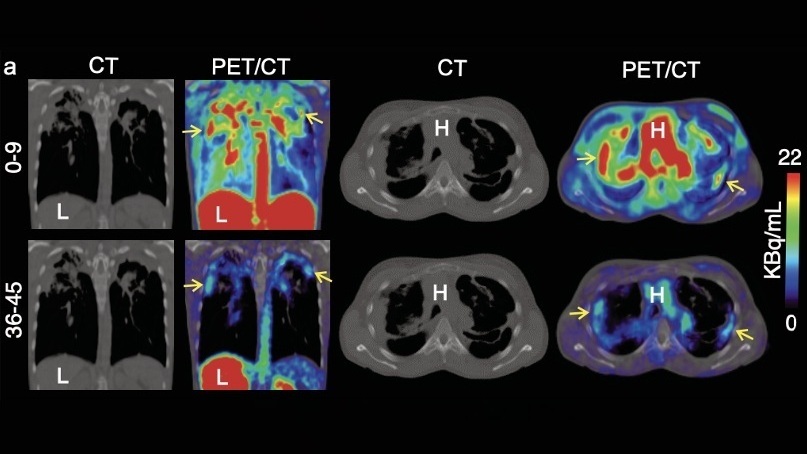
Novel Bacteria-Specific PET Imaging Approach Detects Hard-To-Diagnose Lung Infections
Mycobacteroides abscessus is a rapidly growing mycobacteria that primarily affects immunocompromised patients and those with underlying lung diseases, such as cystic fibrosis or chronic obstructive pulmonary... Read moreImaging IT
view channel
New Google Cloud Medical Imaging Suite Makes Imaging Healthcare Data More Accessible
Medical imaging is a critical tool used to diagnose patients, and there are billions of medical images scanned globally each year. Imaging data accounts for about 90% of all healthcare data1 and, until... Read more
Global AI in Medical Diagnostics Market to Be Driven by Demand for Image Recognition in Radiology
The global artificial intelligence (AI) in medical diagnostics market is expanding with early disease detection being one of its key applications and image recognition becoming a compelling consumer proposition... Read moreIndustry News
view channel
GE HealthCare and NVIDIA Collaboration to Reimagine Diagnostic Imaging
GE HealthCare (Chicago, IL, USA) has entered into a collaboration with NVIDIA (Santa Clara, CA, USA), expanding the existing relationship between the two companies to focus on pioneering innovation in... Read more
Patient-Specific 3D-Printed Phantoms Transform CT Imaging
New research has highlighted how anatomically precise, patient-specific 3D-printed phantoms are proving to be scalable, cost-effective, and efficient tools in the development of new CT scan algorithms... Read more
Siemens and Sectra Collaborate on Enhancing Radiology Workflows
Siemens Healthineers (Forchheim, Germany) and Sectra (Linköping, Sweden) have entered into a collaboration aimed at enhancing radiologists' diagnostic capabilities and, in turn, improving patient care... Read more




